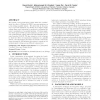Free Online Productivity Tools
i2Speak
i2Symbol
i2OCR
iTex2Img
iWeb2Print
iWeb2Shot
i2Type
iPdf2Split
iPdf2Merge
i2Bopomofo
i2Arabic
i2Style
i2Image
i2PDF
iLatex2Rtf
Sci2ools
DAC
2005
ACM
2005
ACM
Variations-aware low-power design with voltage scaling
We present a new methodology which takes into consideration the effect of Within-Die (WID) process variations on a low-voltage parallel system. We show that in the presence of process variations one should use a higher supply voltage than would otherwise be predicted to minimize the power consumption of a parallel systems. Previous analyses, which ignored WID process variations, provide a lower non-optimal supply voltage which can underestimate the energy/operation by 8.2X. We also present a novel technique to limit the effect of temperature variations in a parallel system. As temperatures increases, the scheme reduces the power increase by 43% allowing the system to remain at it's optimal supply voltage across different temperatures. Categories and Subject Descriptors B.7.1 [Integrated Circuits]: Types and Design Styles; General Terms: Design
| Added | 13 Nov 2009 |
| Updated | 13 Nov 2009 |
| Type | Conference |
| Year | 2005 |
| Where | DAC |
| Authors | Navid Azizi, Muhammad M. Khellah, Vivek De, Farid N. Najm |
Comments (0)

